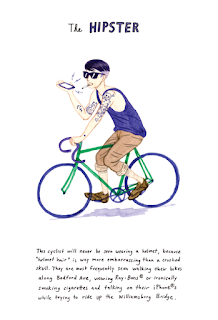Because I've been around bicycles for ever and ever (OK, since the last Ice Age, at least) and because I have a vivid imagination, I can answer all sorts of "What's that?" inquiries. Sometimes I find myself doing that for customers in bike shops even though I haven't worked in one in years.
But I have to admit that yesterday I saw something that stumped me. I was in Bicycle Habitat--where I bought three of my four Mercians--and I saw a bike hanging from the ceiling.
At first glance, I thought it was just another fixie with a weird paint job. I saw the "Langster" name and realized it was yet another iteration of what may be Specialized's best-selling bike, at least in certain urban neighborhoods.
I didn't mind the color scheme, but the graphics were a bit much for my taste. But I couldn't help but to notice another strange detail:
When I saw it, I thought of all of those bikes I see with the stubs or bases of water bottle cages, the cage having broken off. Very often, I suspect, the person riding the bike has no idea of what that piece is, as he or she probably inherited the bike from someone or bought it on Craig's List or in a thrift store. The cage had probably broken off before the person bought or inherited it and the bike probably sat around for years, or even decades.
So I wondered why someone would buy a brand-new bike with a broken-off water bottle cage. One shop employee explained what it is:
"It's a bottle opener," he explained, "shaped like the Golden Gate Bridge."
"Ohh, I see...", which of course I didn't.
All right, I thought, I can understand that someone would feel the need to have a bottle opener on a bike. Such a person probably doesn't carry a keyring, much less a pocketknife or any other implement that would have a bottle opener on it. (If that person were really in the know, he or she would have a Maillard Helicomatic tool, whether or not he or she has a Maillard Helicomatic hub!) After all, such things would not fit into the pockets of a hipster's too-tight jeans--and would poke holes in the pockets of a $200 jersey.
As I was making that completely pointless analysis to myself, the Habitat employee said something that really got me scratching my head: The Golden Gate Bridge bottle opener, he explained "adds about $300 to the base price of the bike".
"And it's a $600 bike".
"Yes, it is. Believe it or not, we just sold one of those--yes, for $900--to a guy from Jersey."
OK, I won't make any snide remarks about Snooki's home state--and not just because I lived there for ten years!
But I have to admit that yesterday I saw something that stumped me. I was in Bicycle Habitat--where I bought three of my four Mercians--and I saw a bike hanging from the ceiling.
At first glance, I thought it was just another fixie with a weird paint job. I saw the "Langster" name and realized it was yet another iteration of what may be Specialized's best-selling bike, at least in certain urban neighborhoods.
I didn't mind the color scheme, but the graphics were a bit much for my taste. But I couldn't help but to notice another strange detail:
When I saw it, I thought of all of those bikes I see with the stubs or bases of water bottle cages, the cage having broken off. Very often, I suspect, the person riding the bike has no idea of what that piece is, as he or she probably inherited the bike from someone or bought it on Craig's List or in a thrift store. The cage had probably broken off before the person bought or inherited it and the bike probably sat around for years, or even decades.
So I wondered why someone would buy a brand-new bike with a broken-off water bottle cage. One shop employee explained what it is:
"It's a bottle opener," he explained, "shaped like the Golden Gate Bridge."
"Ohh, I see...", which of course I didn't.
All right, I thought, I can understand that someone would feel the need to have a bottle opener on a bike. Such a person probably doesn't carry a keyring, much less a pocketknife or any other implement that would have a bottle opener on it. (If that person were really in the know, he or she would have a Maillard Helicomatic tool, whether or not he or she has a Maillard Helicomatic hub!) After all, such things would not fit into the pockets of a hipster's too-tight jeans--and would poke holes in the pockets of a $200 jersey.
| Maillard Helicomatic Tool. The left side is the world's best bottle opener. |
As I was making that completely pointless analysis to myself, the Habitat employee said something that really got me scratching my head: The Golden Gate Bridge bottle opener, he explained "adds about $300 to the base price of the bike".
"And it's a $600 bike".
"Yes, it is. Believe it or not, we just sold one of those--yes, for $900--to a guy from Jersey."
OK, I won't make any snide remarks about Snooki's home state--and not just because I lived there for ten years!






















